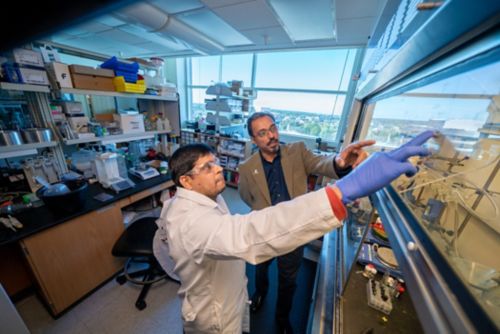St. Jude Family of Websites
Explore our cutting edge research, world-class patient care, career opportunities and more.
St. Jude Children's Research Hospital Home

- Fundraising
St. Jude Family of Websites
Explore our cutting edge research, world-class patient care, career opportunities and more.
St. Jude Children's Research Hospital Home

- Fundraising
Just like the real thing: Synthetic gene expression regulators demonstrate success

First author Ashraf Mohammed, PhD, left, and corresponding author Aseem Ansari, right, explore synthetic genome readers, revealing behavior akin to natural transcription factors
If you ask a professional angler how to catch a fish, the first question they will likely ask is: What kind of fish? Catching specific fish is part of the appeal, with an endless list of baits and lures designed with specificity in mind.
The shape and size of lures have been optimally tuned based on years of careful exploration into the nature of different fish species. Researchers applied this concept to molecular biology and chemistry, applying the same principles behind finely tuned lure design to capture biological systems and harness them therapeutically.
Few biological systems would be more beneficial to capture than gene expression. The ability to control gene expression offers a model for treatment encompassing thousands of conditions, from neurological or cardiovascular diseases to cancers. Modifying gene expression can be accomplished by designing small molecules that interact with specific genes and the expression machinery that regulates them, just like a lure designed to catch one type of fish.
Published recently in the Journal of the American Chemical Society, scientists at St. Jude Children’s Research Hospital built on previous discoveries using synthetic genome readers/regulators (SynGRs) by implementing novel compounds designed to interact more specifically with the factors responsible for gene expression. Through this effort, they developed compounds that behave like natural transcription factors.
The lure of capturing gene expression
“Biology does this all the time, where you have an adapter that brings complexes together to do some particular task, whatever the task may be,” said Aseem Ansari, Department of Chemical Biology & Therapeutics chair. “We made this molecule that binds a specific DNA sequence and then engages a specific type of machine.”
The cellular “machine” this compound was designed to bind to is the bromodomain and extra-terminal domain (BET) family of gene regulators. Ansari has shown the potential of a BET-binding SynGR called SynTEF1 to draw these gene regulators to a specific sequence: genetic irregularities within the FXN gene, which codes for the protein frataxin. These irregularities disrupt the normal production of frataxin, causing Friedreich’s ataxia, a life-limiting neurodegenerative disease. SynTEF1 restores frataxin production to normal levels by dragging BET proteins to where they can kickstart transcription of FXN.
BET proteins are defined by their two bromodomains. These protein regions recognize specific markers on histones, which help package DNA. Binding of the bromodomains of BET proteins to histones opens that specific region of DNA up for transcription factors to engage, and BET inhibitors block this process by occupying the bromodomain binding sites. It is this mechanism that SynGRs exploit, but rather than using the inhibitors to block protein function, the researchers use them like fishing lures, drawing the BET proteins towards genes they wish to express.
SynGing a new song
The SynGR that showed potential against Friedrich’s Ataxia was based on the BET-binding compound JQ1. This compound binds to both bromodomains of BET proteins with no preference for any family member. The researchers wondered whether they could reduce this non-specificity and separately target the individual bromodomains of these proteins, leading to the next generation of BET inhibitors.
“It was shown that if you hit domain one, you have global events, which might be good for cancer, but if you hit domain two, you have far less damage to the system in general,” Ansari said. “So, there are differences between domain one and domain two, and the therapeutic window for domain two may be better.”
Ashraf Mohammed, PhD, a member of Ansari’s team and the first author of the study, wondered what the effect would be if they used these new domain-specific inhibitors in their SynGR design. Would they have the same effect as JQ1?
“I expected that there would be no difference and we were wasting time,” Ansari explained. “To everybody’s delight, domain one inhibitors would not work, and domain two inhibitors worked just as well as the inhibitor that binds both domains [JQ1].”
Different behaviors in bromodomains
However, Ansari was not convinced of the biological relevance of this difference and needed to see what would happen when the new bromodomain-2-specific SynGR had to compete with another BET inhibitor. The results were both convincing and perplexing.
“The domain two inhibitor, free-floating at high concentrations, is now jamming up the works, and our domain two SynGR has to compete with it,” Ansari said. This showed that the SynGR was functioning as expected.
The peculiarity came when the researchers added a domain one inhibitor. “This one, on the other hand, raised activity [of the SynGR]. That was totally surprising,” Ansari said. “Domain two inhibitors behave in a way that allows us to induce the gene, and blocking domain one should not make a difference, but it does. Why does it make a difference?”
Ansari’s team began to see these probes as more than potential therapies but as tools to untangle the molecular recognition principles governing BET protein function. This came after realizing that the SynGRs were not behaving as synthetic mimics artificially hijacking the machinery but were, in fact, behaving like actual transcription factors by demonstrating preferentiality in bromodomain binding.
With evidence that the researchers had lures that function very close to actual transcription factors, Ansari is looking at a bright future for SynGRs beyond treating Friedreich’s ataxia. “There are at least 40 diseases I would love to go after, but the lessons we are learning are not disease-limited. They’re general lessons,” he expressed.
There is anecdotal evidence that one bromodomain generally functions as a chromatin-targeted domain and the other might be a transcription factor-targeted domain. This new work points towards the validity of this specificity.
“We learned something about bromodomains that made us go back and look at how BET proteins interact with their natural substrates. It shows you can use chemistry to gain insights into biology in a way other tools will not.”






